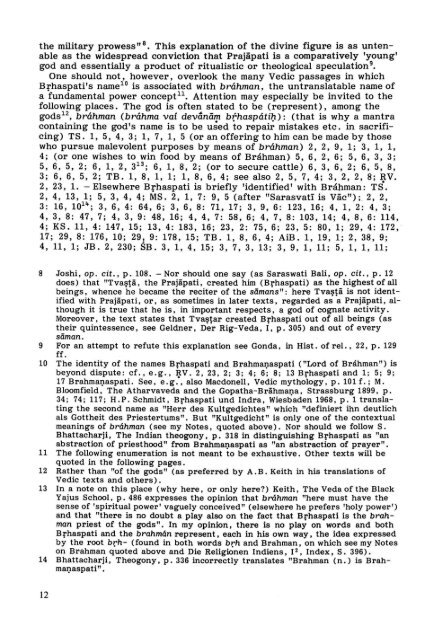Prajapati's relations with Brahman, Brhaspati and Brahma - DWC
Prajapati's relations with Brahman, Brhaspati and Brahma - DWC
Prajapati's relations with Brahman, Brhaspati and Brahma - DWC
You also want an ePaper? Increase the reach of your titles
YUMPU automatically turns print PDFs into web optimized ePapers that Google loves.
the military prowess" 8. This explanation of the divine figure is as untenable<br />
as the widespread conviction that Prajäpati is a comparatively 'young'<br />
god <strong>and</strong> essentially a product of ritualistic or theological speculation 9.<br />
Dne should not, however, overlook the many Vedic passages in which<br />
<strong>Brhaspati</strong>'s name 10 is associated <strong>with</strong> bráhman, the untranslatable name of<br />
a fundamental power concept ll • Attention may especially be invited to the<br />
following places. The god is of ten stated to be (represent) , among the<br />
gOds 12 , bráhman (bráhma vai devano.p brhaspáti1): (that is why a mantra<br />
containing the gOd's name is to be used to repair mistakes etc. in sacrificing)<br />
TS.1, 5, 4, 3; 1, 7,1,5 (oranofferingtohimcanbemadebythose<br />
who pursue malevolent purposes by means of bráhman) 2, 2, 9, 1; 3, 1, 1,<br />
4; (or one wishes to win food by means of Bráhman) 5, 6, 2, 6; 5, 6, 3, 3;<br />
5, 6, 5, 2; 6, 1, 2, 3 13 ; 6, 1, 8, 2; (or to secure catUe) 6, 3, 6, 2; 6, 5, 8,<br />
3; 6,6,5,2; TB. 1,8, 1, 1; 1,8,6,4; see also 2, 5, 7,4; 3,2,2,8; RV.<br />
2, 23, 1. - Elsewhere <strong>Brhaspati</strong> is briefly 'identified' <strong>with</strong> Bráhman: T S·.<br />
2, 4, 13, 1; 5, 3, 4, 4; MS. 2, 1, 7: 9, 5 (after "Sarasvatï is Väc"); 2, 2,<br />
3: 16, lOl"; 3,6,4: 64,6; 3,6,8: 71, 17; 3,9,6: 123,16; 4, 1, 2: 4,3;<br />
4,3,8: 47, 7; 4,3,9: 48,16; 4,4,7: 58,6; 4,7,8: 103,14; 4,8,6: 114,<br />
4; KS. 11, 4: 147, 15; 13,4: 183, 16; 23, 2: 75,6; 23,5: 80, 1; 29,4: 172,<br />
17; 29,8: 176, 10; 29,9: 178, 15; TB. 1,8,6,4; AiB. 1, 19, 1; 2, 38, 9;<br />
4, 11, 1; JB. 2, 230; SB. 3, 1, 4, 15; 3, 7, 3, 13; 3, 9, 1, 11; 5, 1, 1, 11;<br />
8 Joshi, op. cit., p. 108. - Nor should one say (as Saraswati Bali, op. cit., p. 12<br />
does) that "Tval?tä, the Prajäpati, created him (<strong>Brhaspati</strong>) as the highest of all<br />
beings, whence he became the reciter of the sämans": here Tval?tä is not identified<br />
<strong>with</strong> Prajäpati, or, as sometimes in later texts, regarded as a Prajäpati, although<br />
it is true that he is, in important respects, a god of cognate activity.<br />
Moreover , the text states that Tval?tar created <strong>Brhaspati</strong> out of all beings (as<br />
their quintessence, see Geldner, Der Rig-Veda, I, p. 305) <strong>and</strong> out of every<br />
säman.<br />
9 For an attempt to refute this explanation see Gonda, in Hist. of rel., 22, p. 129<br />
ff.<br />
10 The identity of the names <strong>Brhaspati</strong> <strong>and</strong> <strong>Brahma</strong>Qaspati ("Lord of Bráhman") is<br />
beyond dispute: cf., e.g., ~V. 2, 23, 2; 3; 4; 6; 8; 13 <strong>Brhaspati</strong> <strong>and</strong> 1; 5; 9;<br />
17 <strong>Brahma</strong>Qaspati. See, e.g., also Macdonell, Vedic mythology, p. 101 f.; M.<br />
BIoomfield, The Atharvaveda <strong>and</strong> the Gopatha-BrähmaQa, Strassburg 1899, p.<br />
34; 74; 117; H.P. Schmidt, <strong>Brhaspati</strong> und Indra, Wiesbaden 1968, p. 1 translating<br />
the second name as "Herr des Kultgedichtes" which "definiert ihn deutlich<br />
als Gottheit des Priestertums". But "Kultgedicht" is only one of the contextual<br />
meanings of bráhman (see my Notes, quoted above). Nor should we follow S.<br />
Bhattacharji, The Indian theogony, p. 318 in distinguishing <strong>Brhaspati</strong> as "an<br />
abstraction of priesthood" from <strong>Brahma</strong>Qaspati as "an abstraction of prayer".<br />
11 The following enumeration is not meant to be exhaustive. Other texts will be<br />
quoted in the following pages.<br />
12 Rather than "of the gods" (as preferred by A.B. Keith in his translations of<br />
Vedic texts <strong>and</strong> others).<br />
13 In a note on this place (why here, or only here?) Keith, The Vedaofthe Black<br />
Yajus School, p. 486 expresses the opinion that bráhman "here must have the<br />
sense of 'spiritual power' vaguely conceived" (elsewhere he prefers 'holy power')<br />
<strong>and</strong> that "there is no doubt a play also on the fact that <strong>Brhaspati</strong> is the brahman<br />
priest of the gods". In my opinion, there is no play on words <strong>and</strong> both<br />
<strong>Brhaspati</strong> <strong>and</strong> the brahmán rep re sent , each in his own way, the idea expressed<br />
by the root brh- (found in both words brh <strong>and</strong> <strong><strong>Brahma</strong>n</strong>, on which see my Notes<br />
on <strong><strong>Brahma</strong>n</strong> quoted above <strong>and</strong> Die Religionen Indiens, 12, Index, S. 396).<br />
14 Bhattacharji, Theogony, p. 336 incorrectly translates "<strong><strong>Brahma</strong>n</strong> (n.) is <strong>Brahma</strong>Qaspati"<br />
.<br />
12
















